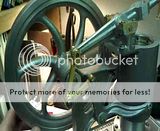idahoan
Well-Known Member
- Joined
- Oct 7, 2008
- Messages
- 594
- Reaction score
- 210
Bill
Great job on your Rider-Ericcson; I'll bet it is going to run real nice. My good friend built one last winter and it runs like a Swiss watch and takes very little heat to operate.
One interesting thing he has had happen on the Teflon power piston packing was after running a while it would shrink and leave a considerable gap. I think eventually he just cut a small piece to fill the gap; because if he replaced the whole thing it would just do it again.
I told him that it was the cheap Chinese packing that he had purchased from the Ace Hardware store.
Thanks for the update,
Dave
Great job on your Rider-Ericcson; I'll bet it is going to run real nice. My good friend built one last winter and it runs like a Swiss watch and takes very little heat to operate.
One interesting thing he has had happen on the Teflon power piston packing was after running a while it would shrink and leave a considerable gap. I think eventually he just cut a small piece to fill the gap; because if he replaced the whole thing it would just do it again.
I told him that it was the cheap Chinese packing that he had purchased from the Ace Hardware store.
Thanks for the update,
Dave


























